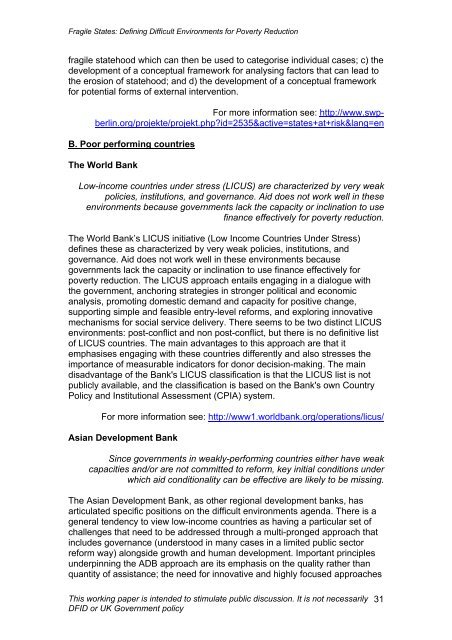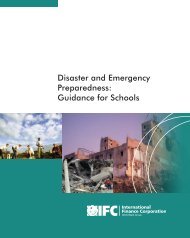Fragile States: Defining Difficult Environments for Poverty ... - INEE
Fragile States: Defining Difficult Environments for Poverty ... - INEE
Fragile States: Defining Difficult Environments for Poverty ... - INEE
Create successful ePaper yourself
Turn your PDF publications into a flip-book with our unique Google optimized e-Paper software.
<strong>Fragile</strong> <strong>States</strong>: <strong>Defining</strong> <strong>Difficult</strong> <strong>Environments</strong> <strong>for</strong> <strong>Poverty</strong> Reductionfragile statehood which can then be used to categorise individual cases; c) thedevelopment of a conceptual framework <strong>for</strong> analysing factors that can lead tothe erosion of statehood; and d) the development of a conceptual framework<strong>for</strong> potential <strong>for</strong>ms of external intervention.For more in<strong>for</strong>mation see: http://www.swpberlin.org/projekte/projekt.php?id=2535&active=states+at+risk&lang=enB. Poor per<strong>for</strong>ming countriesThe World BankLow-income countries under stress (LICUS) are characterized by very weakpolicies, institutions, and governance. Aid does not work well in theseenvironments because governments lack the capacity or inclination to usefinance effectively <strong>for</strong> poverty reduction.The World Bank’s LICUS initiative (Low Income Countries Under Stress)defines these as characterized by very weak policies, institutions, andgovernance. Aid does not work well in these environments becausegovernments lack the capacity or inclination to use finance effectively <strong>for</strong>poverty reduction. The LICUS approach entails engaging in a dialogue withthe government, anchoring strategies in stronger political and economicanalysis, promoting domestic demand and capacity <strong>for</strong> positive change,supporting simple and feasible entry-level re<strong>for</strong>ms, and exploring innovativemechanisms <strong>for</strong> social service delivery. There seems to be two distinct LICUSenvironments: post-conflict and non post-conflict, but there is no definitive listof LICUS countries. The main advantages to this approach are that itemphasises engaging with these countries differently and also stresses theimportance of measurable indicators <strong>for</strong> donor decision-making. The maindisadvantage of the Bank's LICUS classification is that the LICUS list is notpublicly available, and the classification is based on the Bank's own CountryPolicy and Institutional Assessment (CPIA) system.For more in<strong>for</strong>mation see: http://www1.worldbank.org/operations/licus/Asian Development BankSince governments in weakly-per<strong>for</strong>ming countries either have weakcapacities and/or are not committed to re<strong>for</strong>m, key initial conditions underwhich aid conditionality can be effective are likely to be missing.The Asian Development Bank, as other regional development banks, hasarticulated specific positions on the difficult environments agenda. There is ageneral tendency to view low-income countries as having a particular set ofchallenges that need to be addressed through a multi-pronged approach thatincludes governance (understood in many cases in a limited public sectorre<strong>for</strong>m way) alongside growth and human development. Important principlesunderpinning the ADB approach are its emphasis on the quality rather thanquantity of assistance; the need <strong>for</strong> innovative and highly focused approachesThis working paper is intended to stimulate public discussion. It is not necessarilyDFID or UK Government policy31
















